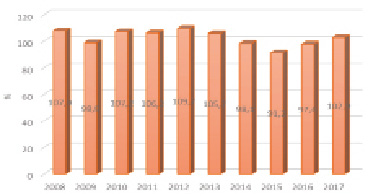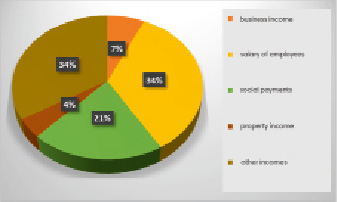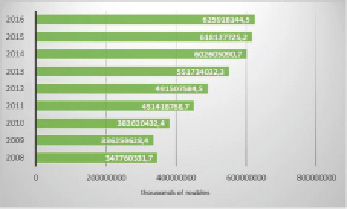There are a lot of ratings that estimate economic, political, social aspects nowadays. This happens through a system of indicators that are included in these criteria. However, the level of well-being has always remained the most important.
Many famous authors were concerned with the study of the level of well-being, for example: J.M. Keynes, V. Leontyev, J. Mintzer, A. Pete, R. Solow, S. Fisher, M. Friedman, etc. A significant contribution to the study of this issue taking the peculiarities of Russia into account was made by such scientists as: Buzlyakov N.I., Glazyev S.Yu., Mayer V.F., Razumov A.A., Rakitsky B.V., Rimashevskaya N.M., Starkov R.F., Uralov V.M., Khaustov Yu.I. and others. Thus, questions of the standard of living have always been payed with great attention, which makes the study of this issue relevant.
The definition of “standard of living” is quite multifaceted and has been considered by many authors. So, many domestic researchers (Mayer V.F., Yarygina T.V., etc.) believed that when assessing the standard of living, the priority of consumption characteristics is determining. These scientists note that only the process of meeting the immediate needs of people is reflected in the concept of the standard of living [1]. A very common approach to the interpretation of the standard of living was the “from the income of the population” approach. In official statistical materials, particularly in the collections of the State Statistics Committee of Russia, all sections listing incomes, wages, pensions, etc. were almost unconditionally related to the assessment of living standards. Thus, the concepts of “standard of living” and “well-being” are often used as synonyms, and an increase in welfare is associated with an increase in the volume of material goods and services aimed to meet the needs of subjects. Thus, the category of “standard of living” and “well-being” is used more and more widely both in scientific works and in everyday practice nowadays. However, there is no doubt that the welfare of the population is one of the most important characteristics of social and economic development.
The purpose of the article is to summarize and systematize various approaches to assessing the quality and standard of living through a system of indicators of such factor as the level of well-being of the rural population and its assessment using the example of rural settlements of the Omsk Region.
The results of the study and their discussion. Currently, one of the most important tasks facing the government is to increase the well-being of the rural population. It should be considered that the rural population combines various social groups, which determines the origin of sources of livelihood. Volumes of rural population depend on the level of well-being, this indicator determines the existence of poverty and its scale. The information obtained from the territorial statistics in this case is an important part of the assessment analasys of public policy effectiveness and an understanding of the causes affecting the level of well-being.
Currently, the Federal State Statistics Service of the Russian Federation (Rosstat) uses a sufficiently big system of indicators characterizing the social status and standard of living of the population in the broad sense of this category and welfare plays a central role in this system of indicators. The existing characteristics of the level of well-being are being analyzed, specified and modified in order to provide valid comparative, not just measurement estimates [2].
There are several forms of welfare:
– wealth is the value of well-being that allows a person to fully develop;
– rational level – the consumption of goods according to certain and established norms, which allows a person to recover their intellectual and physical resources;
– poverty – the amount of income that makes it impossible to recover their strength for working capacity;
– poorness– a consumption that allows you to maintain only vitality and is below all established norms of consumption.
There are factors that influence individual values of indicators, including natural, social and economic, psychological, physiological, in all forms and existing systems of indicators that assess the level of well-being.
Since the concept of “welfare” is diverse and has no defined boundaries, many scientists include a number of indicators, each of them in one way or another characterizes the level of welfare, for example:
– GDP (or GNP) per capita;
– household incomes;
– social transfers;
– savings accumulated in banks and securities;
– food consumption;
– the acquisition of expensive goods (apartments, houses, cars);
– level of education and state of health [3].
All indicators change over time due to objective reasons, some disappear, others appear as more relevant. In Soviet times, they believed that a family had a good level of well-being, if they had a car, a TV, etc. Now the benchmarks have changed and have already replaced the scarce types of goods: computers, tablets, new smartphones, cars, etc. Thus, over time indicators are revised.
Oftentimes the level of welfare is considered by different scientists as a synonym for income, especially in relation to the population and their distribution by social groups. Revenues are usually expressed in money and kind. Sources of income of the population are: wages, pensions, allowances, scholarships, entrepreneurial activities, property leasing, finance and credit, etc.
Let’s consider the level of welfare with the example of rural settlements of the Omsk region, which became the object of study in this article (table 1).
As you can see from table 1 there is an increase in the average monthly nominal wage in the Omsk region as a whole by 26,696.4 rubles in 2000-2016. If we consider this indicator in the context of agriculture, we can see that there is also a growth in wages for agricultural workers by 18 090,8 rubles. As can be seen, it grows from year to year, and is confirmed by the growth in the real average monthly accrued wages as a percentage of the previous year (fig. 1).
The possibilities of the population cannot be assessed only by income, the well-being is also characterized by the amount of income spent, for which we analyze the growth of income and expenditure of the Omsk region population (table 2). It should be noted that the data presented do not go against the information presented above and represent a tendency to increase in both income and expenditure. So, in 2005-2016. the level of consumer spending increased by 12,363.1 rubles against the growth of income by 18,272.1 rubles.
Table 1
Average monthly nominal accrued wages of Omsk region organizations’ employees by types of economic activity (rubles)
|
2000yr |
2008yr |
2009yr |
2010yr |
2011yr |
2012yr |
2013yr |
2014yr |
2015yr |
2016yr |
|
|
Total economics |
1466,1 |
13524,8 |
14780,5 |
16708,2 |
19087,8 |
21931,2 |
24847,9 |
26204,5 |
27233,7 |
28162,5 |
|
including by type of economic activity: |
||||||||||
|
agriculture, hunting |
711,5 |
7665,1 |
8485,5 |
9336,5 |
11000,3 |
12643,6 |
14436,6 |
16110,4 |
17283,6 |
18802,3 |

Fig. 1. The real average monthly salary (as a percentage of the previous year) in the Omsk region
If we consider the distribution of the number of employees according to the size of the accrued wages in April 2017, then it should be noted that the largest proportion of workers (11.4 %), is paid from 25,000 to 30,000 rubles, the category of population 9.5 % with income from 18,600.1 to 21,800.0 rubles is in the second place, a population of about 8.1 % with income from 30,000.1 to 35,000.0 rubles is in third place and the smallest group consists of people with a minimum wage of 2 % less than 7,500 rubles. The number of employees who receive a salary of more than 250,000 rubles is only 0.1 %.
Table 2
Cash income and consumer spending of the population of the Omsk region (per capita; rubles, per month)
|
Cash income of the population per capita |
Consumer spending per capita |
|
|
2005yr |
6969,1 |
4581,8 |
|
2006yr |
9084,2 |
5678,2 |
|
2007yr |
11450,7 |
7177,1 |
|
2008yr |
13801,5 |
9060,3 |
|
2009yr |
14061,1 |
9386,3 |
|
2010yr |
15199,0 |
10401,7 |
|
2011yr |
17247,9 |
12663,1 |
|
2012yr |
19494,6 |
14513,0 |
|
2013yr |
21363,6 |
16222,6 |
|
2014yr |
24060,2 |
17408,6 |
|
2015yr |
25839,5 |
17255,2 |
|
2016yr |
25241,2 |
16944,9 |
Let’s analyze the income distribution of the population of the Omsk region (fig. 2). A fairly high proportion of incomes of the population of the Omsk region in 2016 were incomes in the form of wages of hired workers 34.4 %, the category of other incomes is in the second place 33.5 % and social payments are in the third place 20.8 %.
Let’s consider income indicators at the macro level, that means at the level of the gross regional product of the Omsk region. In 2017, the turnover of the Omsk region in all types of economic activity amounted to 1 726 308,2 million rubles, which is 106.3 % more than in 2016. If we consider this indicator relative to agriculture, then the total turnover from it amounted to 38 021,1 million rubles in 2017, which is 97.9 % less than in 2016. Let’s analyze the formation of the gross regional product of the Omsk region by income sources at current basic prices, which makes it possible to say that in 2016 the total value of the gross regional product amounted to 625 918 144,5 thousand rubles, including: the remuneration of employees – 234 178 320,8 thousand rubles, other net taxes on production – 7 135 208,3 thousand rubles, gross profit of the economy and gross mixed incomes – 384 604 615,4 thousand rubles (fig. 3).
The Omsk region in the Russian Federation in terms of the gross regional product took the 30th place in 2016, compared to 2015, where it was on the 29th place. In the Siberian Federal District, Omsk Region ranked fifth in 2016 and 2015 [4].

Fig. 2. Structure of cash income of the population of the Omsk region in 2016 (as a percentage of the total cash income of the population), %

Fig. 3. The volume and dynamics of the gross regional product of the Omsk region in 2008-2016
Analyzing 2016 data in terms of activities, it should be noted that in 2016 in the Omsk region the largest share in the structure of the gross regional product by type of economic activity in the current basic prices takes manufacturing production – 37.3 %, the second place was retail, repair of motor vehicles, motorcycles, household goods and personal items – 11.7 %, third place went to real estate operations, rent and the provision of services – 9.9 %. The smallest share belongs to the financial activity of 0.3 %. In 2016, the gross regional product per capita increased and amounted to 316.8 thousand rubles. [5]
Thus, the administration of the Omsk region pursues an active policy of stimulating wage growth in all sectors of the economy. The relevance of these measures is reinforced by the fact that wages at the expense of the personal income tax has become the main source for the formation of the budget of the Omsk Region since 2002. However, due to the lack of high-yield jobs in the Omsk Region, a significant proportion of the working population works outside the region. According to estimates made by the Economic Committee of the Omsk Region Administration, about 70 thousand Omsk people work in the north. If these people were employed on the territory of the Omsk Region, the gross regional product could increase by 7 %, the average salary by 10-15 %, and the consolidated budget revenues by 90 million rubles [6].
Attempts to measure and assess the level of well-being have been made by various scientists for quite some time, along with these attempts various methods of assessment were proposed through a system of indicators. Some of these indicators are used in their annual reports by statistical bodies at both federal and regional levels. At the same time, the shortage of this assessment at present is the lack of income differentiation in the context of the urban and rural population, which makes it difficult to conduct an analysis to assess the level and quality of life of rural settlements. There is no single sound methodology for assessing the welfare of the rural population and the population in general at the moment, which makes this question relevant and open to new scientific ideas.
«Study of the system of indicators of the level and quality of life within rural population, allowing to evaluate the results of social development of rural areas of the Omsk region”, project No. 18-410-550024 р_а.

